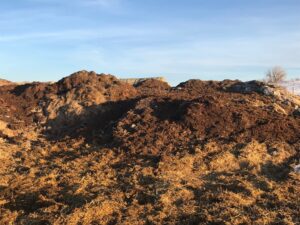Do Synthetic Hormones Used in Beef Production Have Environmental Effects When Excreted?
Titre de Projet
Assessment of Occurrence of Synthetic Hormones (Melengestrol Acetate and Trenbolone Acetate) and Beta-Agonist (Ractopamine) in Cattle Operations and Associated Environments
Des Cherchers
Francis Larney, Ph.D. and Paul Jones Ph.D. francis.larney@agr.gc.ca
Francis Larney, Ph.D. (Agriculture Agri-Food Canada Lethbridge); Paul Jones Ph.D. (University of Saskatchewan); Tim McAllister Ph.D., and Srinivas Sura Ph.D. (Agriculture Agri-Food Canada), John Giesy Ph.D. (University of Saskatchewan)
Revues Scientifiques
| Le Statut | Code de Project |
|---|---|
| Terminé en March, 2021 | ENV.09.17 |
Background
Natural growth promotants (estrogen, testosterone, progesterone) and synthetic growth promotants (zeranol, trenbolone acetate TBA, melengesterol acetate MGA, ractopamine RAC) are used to improve the growth rate and efficiency of cattle. They also have environmental benefits due to decreased resource use and greenhouse gas production. However, there are concerns that growth promotant residues excreted in manure or urine may have negative environmental effects, including potential hormone-disrupting effects that impact reproduction and development of fish and amphibians. Very little research has been done in Canada, and data from other countries may not reflect Canadian field conditions. Lab-based studies may use hormone or manure concentrations, temperature and pH conditions that are not representative of production or natural environments.
Objectives
- To quantify concentrations of MGA, TBA, RAC and their metabolites in feces and manure from cattle administered with these growth promoters, in surface runoff from pens, on cropland that has had manure spread on it, and in ground water in areas around feedlots. Researchers will also evaluate effectiveness of windrow composting and manure stockpiling in dissipating MGA, TBA, and RAC residues and evaluate endocrine disrupting effects of these compounds.
What They DID
This team fed two sets of cattle in 2017-18 and 2018-19. There were six experimental treatments: (1) control heifers (no growth promotants), (2) heifers implanted three times with TBA at 80-day intervals, (3) heifers continuously fed MGA, (4) control steers (no growth promotants), (5) steers implanted three times with TBA at 80-day intervals, and (6) TBA-implanted steers fed ractopamine for the last 42 days. Altogether, the experimental treatments included an implant (released and excreted at low rates over a long period), one feed additive (fed and excreted daily at low levels over a long period), and a second feed additive (fed and excreted at a high rate for a short period).
Samples of fresh feces and manure were collected from the pen floor on a set schedule to monitor residue levels in feces and manure, from catch basins, and groundwater under the feedlot. Simulated rainfall experiments were also carried out to estimate how much residue would be released during a one in 100-year rainfall event in both feedlot pens and pastures that received manure. For comparison purposes, pen floor samples were also collected from two commercial feedlots that used TBA, MGA and ractopamine and two that used natural (no growth promotant) production systems. They also studied residue breakdown when manure was stockpiled or composted for 28 days.
What they Learned
Not surprisingly, no growth promotant residue or metabolites were detected in the control groups or natural feedlot pens. In pens where cattle did receive growth promotants, residue levels were higher in fresh feces than in manure. The straw and soil in manure diluted the residues, and microbial activity in manure breaks these residues down faster. Residues also degraded faster in summer than in winter.
Pen floor samples: TBA residues and metabolite levels mirrored the gradual implant release; both declined over time, dissipating very quickly and were undetectable within three weeks after the final implant was given. All TBA residues and metabolites were long gone before the empty pens were restocked with the next set of cattle.
MGA residues were more stable throughout the feeding period, likely because they were administered continuously in feed at a low level. These residue levels also fell quite quickly once the feeding period ended, and residues and metabolites were gone before the pens were restocked.
Once ractopamine feeding started (later in the feeding period), its residue levels in manure were three- to four- times higher than for TBA or MGA (because ractopamine is fed at a much higher rate for a shorter time). Ractopamine residues also broke down more slowly than TBA and MGA residues. When pens weren’t cleaned after the first feeding trial, ractopamine residues were still detected in manure when the second set of cattle arrived 5 months later. However, the ractopamine residues from the first trial were undetectable by the time ractopamine feeding started late in the second trial.
Manure composting or stockpiling broke down over 95% of ractopamine residues in less than a month, approximately 3-8 times faster than when manure was left in the pens.
Rainfall experiments and catch-basin samples: After a simulated one in 100-year rainfall, TBA and MGA residues were virtually undetectable in runoff water directly from feedlot pens or from manured pastures, but ractopamine residues were detected. Catch-basin samples showed similar results.
Groundwater: No TBA, MGA or ractopamine residues were found in groundwater. The hard-packed gley layer below the manure pack presumably blocked the downward movement to groundwater.
What It Means
TBA and MGA residues occur at low levels in feedlot feces and manure, break down very rapidly and are unlikely to enter catch-basin or surface water or agricultural soils. Ractopamine residues are found at higher levels and last longer but can be effectively managed by composting or stockpiling manure.
Growth promotants provide significant production and environmental benefits. This study found that their residues pose minimal risks to the environment, and these can be further minimized by appropriate manure and runoff management.
